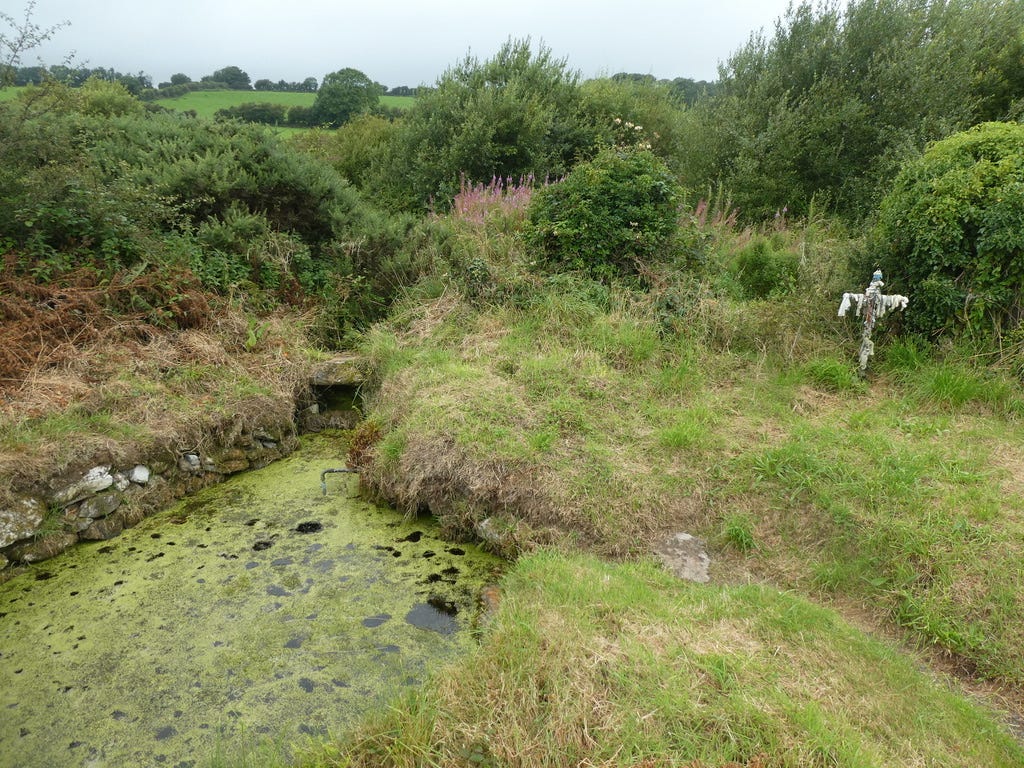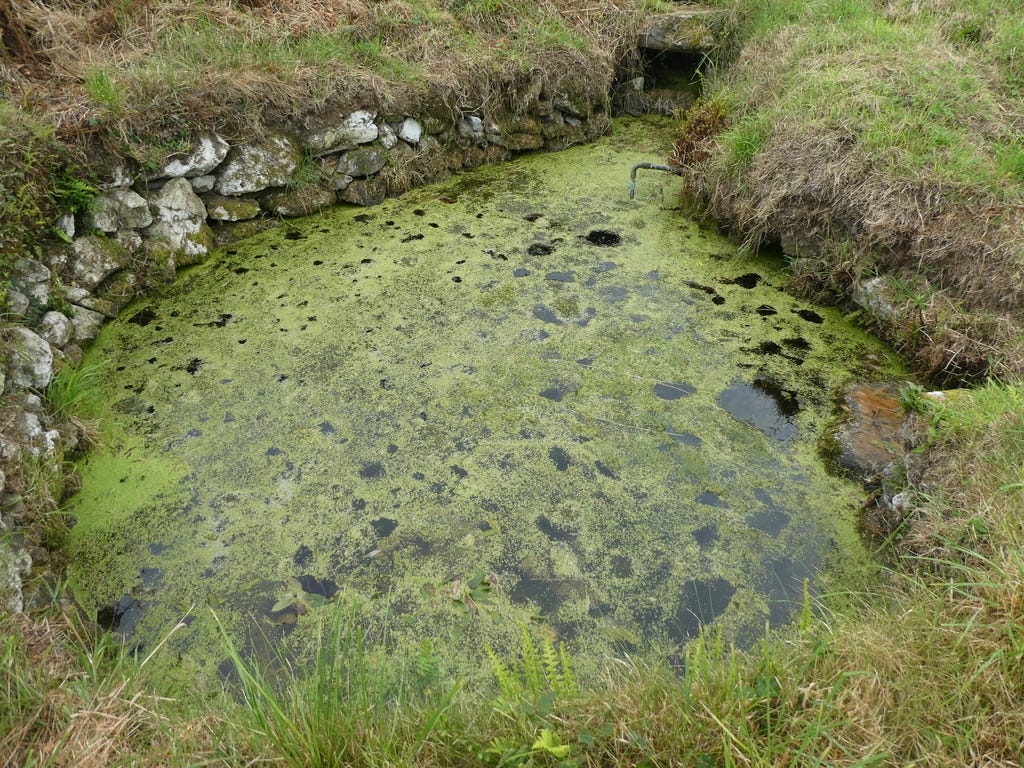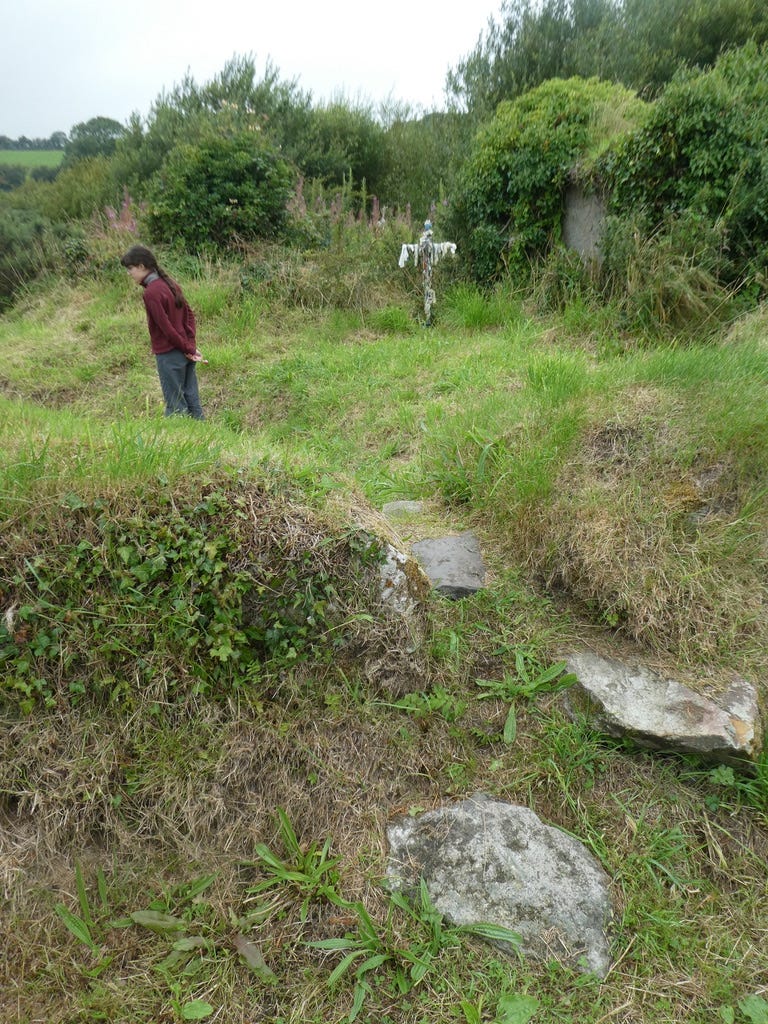St Ita’s well, Kill, County Waterford
Last week we were in Ireland’s far northwest. This time around we are near its southeast tip, where the weather is better but the landscape less spectacular. Though there are some great beaches. Again I am driving, as I so often seem to find myself doing, down a tiny lane, this time with my daughter, in search of a red dot on a map. Well-hunting does improve your driving skills. If you decide to seek out obscure religious sites in the Irish countryside, you are going to have to get good at reversing and at three-point turns on a regular basis.
The only clue that this well squats in a quiet green hollow by the side of the road is a curious sight seen briefly through the van window as we pass; something I’ve not seen before at any Irish well. Not a rag tree, but a rag cross:
Usually a thorn tree - black or white - plays the role given here to the cross: to be a repository of garments or objects used to seek healing. This time around, as so often, we can see socks, handkerchiefs, shreds of shirt or T-shirt, rosaries and other items of clothing tied to the cross. It makes for an arresting sight.
It’s worth saying something about this practice, which we’ve encountered now many times. The existence of such things as rag trees and, indeed, rag crosses at well sites is one of the reasons that the Catholic Church - not to mention the Protestant denominations - has for so long officially frowned on the wells. What we have here is basically an example of what is often called ‘sympathetic magic.’ That phrase, which is common in neo-pagan and occultish circles, can be traced back to Sir James Frazer’s highly influential Victorian tome on mythology The Golden Bough, in which Frazer tries to define a practice which appears in almost all cultures, and which is obviously ancient. He writes about it like this:
If we analyze the principles of thought on which magic is based, they will probably be found to resolve themselves into two: first, that like produces like, or that an effect resembles its cause; and, second, that things which have once been in contact with each other continue to act on each other at a distance after the physical contact has been severed. The former principle may be called the Law of Similarity, the latter the Law of Contact or Contagion … from the second he infers that whatever he does to a material object will affect equally the person with whom the object was once in contact, whether it formed part of his body or not.
This is effectively what is going on here. A piece of material, or an object, belonging to a sick person is brought to the well and either dunked in the water or tied to a tree/cross with appropriate prayers, in order that the saint associated with the well might cure the sickness.
It’s not too much of a leap to imagine that before some of these wells were Christianised, it was the water itself, or the gods or spirits associated with it, which provided the healing. A modern pagan might certainly argue that the whole tradition of rag trees at wells is a pre-Christian magical practice smuggled into Christianity - hence the disapproval of the bishops and priests. A Christian, though, might counter that what is happening here is not so very different from what happened when a woman touched the hem of Jesus’s robe as he passed by, in a desperate search for healing for her long-term sickness. Christ gave his followers the power to heal, after all. Why would prayers to a saint not have the promised effect?
However you see it, the water today doesn’t look like the kind of place in which a healing spirit would dwell:
The scum of algae makes the water look pretty unappealing. For all I know, it may well be a product of the kind of nitrogen-rich agricultural runoff which pollutes so many water sources across the country. But if you look closely enough, you can see that the well still lives. Stand at the edge, and you will see little clusters of bubbles periodically rising to the surface. This well is a freshwater spring, which rises gently and constantly from below the ground. Then it flows off through the little stone opening you can see at the top of the picture, and waters the nearby bog.
Local tradition here tells that these bubbles can be made to appear on command. You stand at the water’s edge and say ‘boil, boil, blessed well’, and they will rise to the surface. Another story tells of a trout that lives in the well. If he’s ever caught, the bubbles will stop appearing, and the well will run dry - unless you put him back sharpish. I would not especially fancy being a trout in these waters today.
There is nothing at this lonely site which explains which, if any, saint is associated with the well, but later research suggests the well was once dedicated to St Ita of Killeedy. Like Brigit, who I wrote about here recently, Ita was one of a legion of formidable woman saints produced by early Irish Christianity. She is sometimes known as the ‘mother (or foster mother) of the saints’, because of the foster school she ran at the monastery she founded. Numerous Irish saints were raised and taught by Ita, most famously St Brendan the Navigator, who may have discovered America long before Columbus turned up ten centuries later.
A story is told that young Brendan once asked Ita what pleased and displeased God the most in a person. Ita is said to have replied:
The Lord loves three things in a Christian most of all: faith in God with a pure heart; a spiritual Christian life with simplicity; and open-handed love. But the Lord especially dislikes hatred in our hearts; persistence in sin; and excessive reliance on money.
Today’s well, then, comes with lessons attached. Follow Ita’s guidelines, tie a rag to the cross and mind that you don’t catch the trout. Then you should have no troubles.









Sub atomic particles that were once together continue to influence each other even when separated by space and time... Its unknown how this happens. I'm the daughter of a Catholic (world renowned within his field) quantum physicist.
These are so interesting to see! And learn about new(to me) saints too.
I don't see this as too far removed from the use of relics which can be found in many Catholic churches, there is splinter of bone of St Anne in Quebec at the Cathedral there...
If I remember correctly a recent relic was traveling to be touched and seen by the members of a Catholic church in my area... maybe from the recent death of a nun in the midwest whose body after being exhumed was found uncorrupted? This was reported in the Catholic press but not by the MSM.
Which tends to ignore these stories or make fun of them..Which makes me think of the work of Ian Mcgilchrist 'The master and his Emissary'... left brained vs right brain functioning. The left is so concrete and logical and has no concept of the mystical. And we are culturally so left brained.